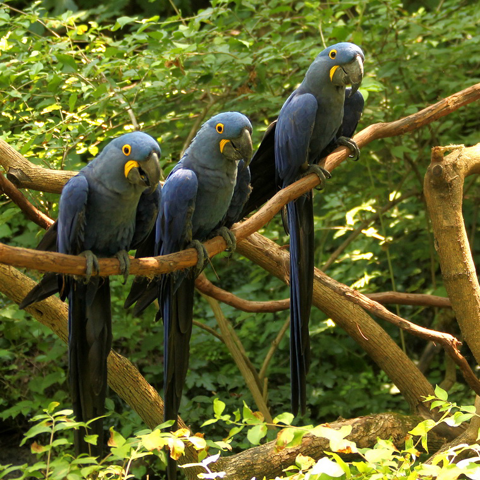Summary of Bird Updates:
The Nashville Zoo has introduced a blue-billed curassow named Albert to the bird area of Critter Encounters, acknowledging the species as one of the most endangered in the world, with an estimated 250 individuals remaining in Colombia. Albert, hatched in May 2014 at the White Oak Conservation Center in Florida, is part of a Species Survival Plan (SSP) to ensure a sustainable population of these rare birds in zoos. While efforts are made to bolster their numbers in captivity, conservation groups in South America, like Fundación ProAves, focus on habitat preservation and education. With Albert’s addition, the zoo bid farewell to a black-throated magpie jay, Bernard, and golden pheasants, which were moved to make space for Albert and potentially a recommended female companion soon.
Additionally, the zoo’s hyacinth macaws have been temporarily off-exhibited due to construction work on a new zoo entrance. During this period, keepers engage them with toys, puzzle feeders, and a detailed training program to ensure they stay healthy and stimulated. Once the construction is complete, the macaws are expected to return to their exhibit and continue greeting zoo visitors.
– The significance of Species Survival Plans (SSPs) in conserving endangered birds like the blue-billed curassow
– The challenges and adaptations involved in zoo management and wildlife conservation
– The impact of habitat preservation and educational efforts on bird conservation
– The importance of enrichment activities for birds in captive settings
– Transition and adaptation practices for avian species during zoo renovations and expansions
Zoos and wildlife conservation centers play a pivotal role in preserving endangered species, employing various strategies to ensure the survival of species at risk of extinction. Among these efforts, the Species Survival Plan (SSP) is critical in managing and sustaining genetically diverse and demographically stable species populations like the blue-billed curassow. This rare bird species, with an estimated population of only around 250 individuals remaining in the wild, is emblematic of the conservation challenges and strategies that zoos worldwide face.
The blue-billed curassow, now part of the Nashville Zoo collection, exemplifies the collaborative efforts required to save critically endangered species. Hatched in 2014 at the White Oak Conservation Center, Albert represents hope for the future of his species. The SSP guidelines for breeding and management have facilitated his arrival in Nashville, highlighting the critical role that zoos play in breeding and the broader context of global conservation efforts.
Efforts to conserve species like the blue-billed curassow must address both in-situ and ex-situ conservation strategies. While zoos focus on creating viable populations through breeding programs, organizations such as Fundación ProAves in South America concentrate on habitat preservation and local community education. These complementary approaches are essential for the long-term survival of endangered species, combining the strengths of local and global conservation initiatives.
In addition to these large-scale efforts, daily management practices and adaptations within the zoo environment are equally crucial. For birds in captivity, enrichment activities are vital for their physical and mental health. Whether using puzzle feeders, varied objects for manipulation, or engaging in a detailed training program, keepers work tirelessly to simulate a more natural environment for species like the hyacinth macaws during their off-exhibit periods. Such practices underscore the adaptability and creativity required from zoo professionals to maintain the well-being of their avian charges.
The relocation of birds, as seen with the hyacinth macaws during construction at the Nashville Zoo, further illustrates the complexity involved in zoo management. It is an opportunity to reassess and improve exhibit spaces, but it also requires significant planning to reduce stress on the animals and maintain their care standards. Similarly, decisions about introducing new species, like Albert, or the transition of others to different facilities reflect a holistic approach to zoo management that considers the needs of individual animals and the zoo’s contribution to broader conservation goals.
The narrative of bird changes at Nashville Zoo’s Critter Encounters, including Albert’s introduction and other avian transitions, provides a window into the multifaceted world of zoo management and wildlife conservation. These efforts are underscored by a commitment to education, research, and collaboration to foster a sustainable future for endangered species. Engaging visitors with these stories fosters a deeper understanding of conservation challenges and zoos’ role in addressing them.
As zoos evolve, their role in conservation, education, and research becomes increasingly significant. Incorporating innovative practices in enrichment, habitat design, or community engagement remains key to their success. Through these endeavors, zoos provide refuge for endangered species and become centers of conservation action and awareness, bridging the gap between humans and the natural world.
These initiatives, exemplified by the experiences of Albert the blue-billed curassow and the hyacinth macaws at Nashville Zoo, highlight the relentless pursuit of a delicate balance. It is a pursuit of harmony between human activity and wildlife preservation, where every effort marks a step towards a more sustainable coexistence. In this light, the story of bird changes at Critter Encounters is not just one of management and care but a testament to the enduring spirit of conservation.


